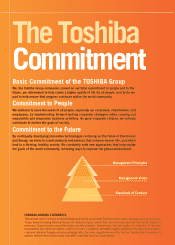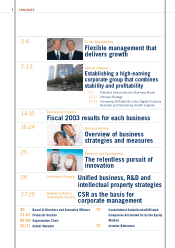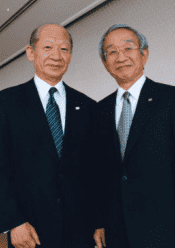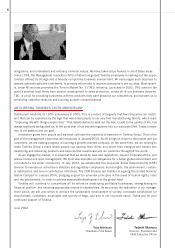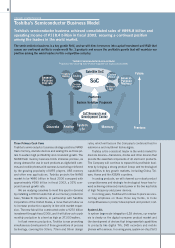Toshiba 2004 Annual Report Download - page 5
Download and view the complete annual report
Please find page 5 of the 2004 Toshiba annual report below. You can navigate through the pages in the report by either clicking on the pages listed below, or by using the keyword search tool below to find specific information within the annual report.
3TO OUR SHAREHOLDERS
OVERVIEW OF FISCAL 2003
Fiscal 2003, ended March 31, 2004, opened in uncertainty, with contin-
ued deflation in the domestic economy and concerns about the international
impact of the war in Iraq. The second half of the fiscal year was more
settled, however, with the corporate sector showing renewed confidence as
exports turned favorable and capital expenditure began to increase slightly.
Digital consumer products emerged as clear favorites in the market,
boosting sales of digital still cameras, mobile phones and digital flat-panel
TVs in both Japan and overseas markets, including China and the United
States. However, the commoditization of portable PCs gathered steam and
made a strong impact on Toshiba Corporation’s performance.
Amid these conditions, Toshiba’s consolidated net sales for fiscal 2003
totaled ¥5,579.5 billion, a 1% decline compared with the previous fiscal year. Excluding the effect of business
transfers, however, sales rose approximately 2% year on year. More significant indictors of the Company’s im-
proved performance are the 51% surge in operating income, to ¥174.6 billion, and the 56% jump in net income,
to ¥28.8 billion.
Electronic devices made a robust contribution to this performance, led by the superior quality and global
strength of the Company’s semiconductors. Digital products fell short of targets as a result of slow sales of color
TVs, mobile phones in overseas markets, and especially portable PCs.
The substantial increase in profitability achieved in fiscal 2003 was the result of rising earnings in the
electronic devices business, along with positive effects of structural improvement measures carried out under the
01 Action Plan.
RESULTS OF THE 01 ACTION PLAN
Fiscal 2003 marked the culmination of our three-year 01 Action Plan, which supported us in developing pro-
grams for intensified competitiveness and streamlined management and in defining corporate initiatives to improve
operating efficiency.
Measures for improved competitiveness included our 2002 withdrawal from the general-purpose dynamic ran-
dom access memory (DRAM) business and a series of major joint ventures, with Matsushita Electric Industrial Co.,
Ltd. in liquid crystal displays (LCDs) and cathode ray tubes (CRTs), and with Mitsubishi Electric Corporation in the
power transmission and distribution businesses and the industrial electric and automation systems businesses.
During the course of the plan we also reduced the number of Group employees from 188,000 to 161,000,
and promoted an “asset-light” strategy that reduced assets by ¥1,200 billion, surpassing the original target of
• Withdrew from the general-purpose DRAM business
• Restructured the LCD and CRT businesses in joint ventures with
Matsushita Electric Industrial Co., Ltd.
• Restructured power transmission and distribution businesses
and industrial electric and automation systems businesses in
joint ventures with Mitsubishi Electric Corporation
20% reduction achieved
14% reduction achieved
161,000 employees (as of March 31, 2004)
¥1,200 billion reduction achieved
Accomplishments of the 01 Action Plan
AccomplishmentsGoal/Target
Restructure businesses
Reduce assets (asset-light strategy)
by ¥800 billion
Reduce number of Group personnel
by 10% from 188,000 employees
(as of March 31,2001)
Reduce procurement costs
by 20% over two years
Tadashi Okamura,
Director, President and Chief Executive Officer


